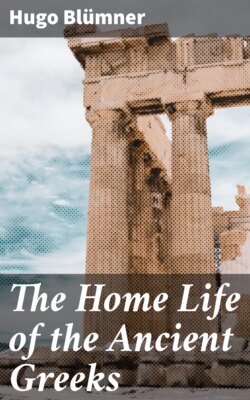The Home Life of the Ancient Greeks

Реклама. ООО «ЛитРес», ИНН: 7719571260.
Оглавление
Hugo Blumner. The Home Life of the Ancient Greeks
The Home Life of the Ancient Greeks
Table of Contents
INTRODUCTION
GREEK LIFE AT HOME
CHAPTER I. COSTUME
CHAPTER II. BIRTH AND INFANCY
CHAPTER III. EDUCATION
CHAPTER IV. MARRIAGE AND WOMEN
CHAPTER V. DAILY LIFE WITHIN AND WITHOUT THE HOUSE
CHAPTER VI. MEALS AND SOCIAL ENTERTAINMENTS
CHAPTER VII. SICKNESS AND PHYSICIANS, DEATH AND BURIAL
CHAPTER VIII. GYMNASTICS
CHAPTER IX. MUSIC AND DANCING
CHAPTER X. RELIGIOUS WORSHIP
CHAPTER XI. PUBLIC FESTIVALS
CHAPTER XII. THE THEATRE
CHAPTER XIII. WAR AND SEAFARING
CHAPTER XIV. AGRICULTURE, TRADE, AND HANDICRAFT
CHAPTER XV. SLAVERY
LIST OF AUTHORITIES CONSULTED FOR THIS BOOK
I.—Works Bearing on the Subject Generally
II.—Works Dealing with Special Subjects
1. Costume
2. Birth and Early Childhood
3. Education
4. Marriage and Women
5. Daily Life within and without the House
6. Meals and Social Entertainments
7. Sickness and Physicians; Death and Burial
8. Gymnastics
9. Music and Dancing
10. Religion
11. Games and Festivals
12. The Theatre
13. War and Seafaring
INDEX
Отрывок из книги
Hugo Blümner
Published by Good Press, 2021
.....
From this time onward the name “himation” was used for the cloak worn with the chiton, while “chlaina” was only retained for a special kind, distinct rather by its material than by its shape. The himation was often worn in the oldest period in the way described above, that is, with two points falling on the two sides in front. (Compare the Hermes in Fig. 4.) But it became more and more common, and from the classic period onwards quite universal, to fold the cloak tightly round, and this was done as follows. One point was drawn from the back over the left shoulder and held fast here between the chest and arm, then the cloak was drawn round over the back in wide folds reaching to the shins, and from there back again to the front on the right side. This was done in two ways. If the right arm was to be kept free the himation was drawn through under the right shoulder and in front folded across the body and chest, while the last piece was thrown back across the left shoulder (compare the Paris in Fig. 4 on the left), or else over the left arm (compare the man on the right in Fig. 4). The other mode, and the one common in the dress of an ordinary citizen, was to draw the cloak over the right arm and shoulder, so that at most the right hand was exposed, and then to throw it back again over the left shoulder. This arrangement was facilitated by small weights of clay or lead sewn on
.....